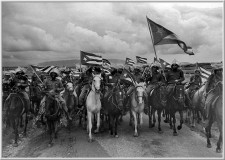
Raúl Corrales
Cuban, 1925-2006
The Fishing Net (La Atarraya), 1950 ca.
gelatin silver print
14 3/4 x 19 1/4 in.
SBMA, Museum purchase with funds provided by the Cheeryble Foundation
2002.22.2

Photo of Raúl Corrales 1979 © Pedro Meyer
On Corrales:
"He documented one of the most important events in 20th century history,"
- Darrel Couturier
"Corrales was political, but there is also a romance in his work," said Constantine Grimaldis, owner of the C. Grimaldis Gallery in Baltimore, who exhibited Corrales' work in a 2002 show curated by Darrel Couturier.

He covered a number of political protests and was harassed several times by political bosses who supported Batista. "Corrales' picture of Castro's triumphant entry into Havana at the head of a ragtag rebel army packs the emotional punch of such images as Washington crossing the Delaware," wrote a reviewer for the Baltimore Sun in 2002. Once Castro was in power, Corrales traveled with him as a photojournalist on several occasions, including a trip to Venezuela. In 1962 Corrales was named director of Cuba's Office of Historical Matters, which houses the government archive of the revolution. He remained there until he retired in 1991.
COMMENTS
Raul Corrales was a Cuban photographer who documented the country's political revolution of the 1950s in bold and poetic images. He was known as one of the leaders in his field in the post-Revolutionary period of Cuba.
Born in 1925, Corrales was for almost 60 years "a paradigm of Cuban photography" and his death in 2006 represents "a regrettable loss" to Cuban culture.
Along with Alberto Diaz "Korda," author of the most famous photo taken of Argentine-born Cuban revolutionary icon Ernesto "Che" Guevara; and Osvaldo Salas; Corrales is recognized as one of the leading figures of the so-called "Epic Photography of the Cuba Revolution" period that followed Fidel Castro's rise to power in 1959. He also is known for important photographs of the April 1961 Bay of Pigs invasion.
He was one of the great Cuban photo-reporters. Critics highlight his ability to synthesize, to show details and his sculptural treatment of light without blotting out the meaning of the direct message, a way of looking at life and the noble way in which he treated human beings.
One of his photos: The Dream, is considered among the one hundred best images in the history of photography. But beyond this or that title, Raul Corrales (National Plastic Arts Award) gave testimony and graphically documented the early years of the Cuban Revolution.
There isn’t one important event in that period which his lens did not capture.
That was from 1959 to 1964, when Corrales was a member of the photographic teams in Revolucion daily and Cuba magazine. Before, in Carteles magazine, his work had also been outstanding.
He reached the most unimaginable places in Cuba to show how the poor farmers in the mountains and the coal makers in the marshes, the sugar-cane cutters and the miners lived and died. Those coverage’s were true denunciations, a call for awareness.
One of the few, if not only photographer in the world, to have a photograph of his become an image, in the currency of his country, Cuba. Raul Corrales had such a distinction.
“When there is no longer misery in Cuba,” said Alberto Korda, one day to Raul Corrales, “you’re going to starve to death.” By sheer miracle, Corrales hadn’t starved to death until then. Before he started in photography, he was forced to undertake the most modest jobs: newspaper boy, fruit seller, a shoeshine boy, and cleaning boy… Also, a valet to Mexican filmmaker Jorge Negrete during his presentations in Cuba…
He was able to save enough money to buy a small 127 mm camera. He took pictures with it but he didn’t print them. He was happy to look at the negatives with a magnifying glass before a lamp. That was when he landed a job with Cuba Sono Films and became a professional photographer. It was 1944.
Long gone are the times of Raul Corrales, carrying a 4 x 5 Speed Graphic camera and a bag full of film and bulbs, wondered throughout Havana looking for news. When he turned 80, he had an archive with thousands of unprinted negatives and four books published, one of which is dedicated to Ernest Hemingway. His photographs remain and his prestige becomes greater each day, inside and out of the island.
2006 © The Denver Post
Snapshot of Raul Corrales, by Ciro Bianchi Ross, Cubanow © Ciro Bianchi Ross
http://www.zonezero.com/magazine/obituaries/corrales/index.html
SBMA CURATORIAL LABELS
An everyday activity for the inhabitants of the small fishing village of Cojimar, casting a net becomes an elegant dance in Raúl Corrales’ poetic image. In the late 1940s and early ’50s, Corrales spent much of his time photographing rural life in Cuba, inspired by the photographers of the Farm Security Administration in the United States, such as Walker Evans and Dorothea Lange.
In 1959, he joined a photographic team working for "Revolución", the new government newspaper, and eventually became Fidel Castro’s official photographer. His photographs were more than mere documentation; they became icons of the Cuban Revolution (1953-59). Corrales famously photographed Castro at a fishing tournament with Ernest Hemingway in 1960. The author spent much of his time in Cojimar, which inspired him to write The Old Man and the Sea.
- Myth and Materiality: Latin American Art from the Permanent Collection, 1930-1990 (2013)
